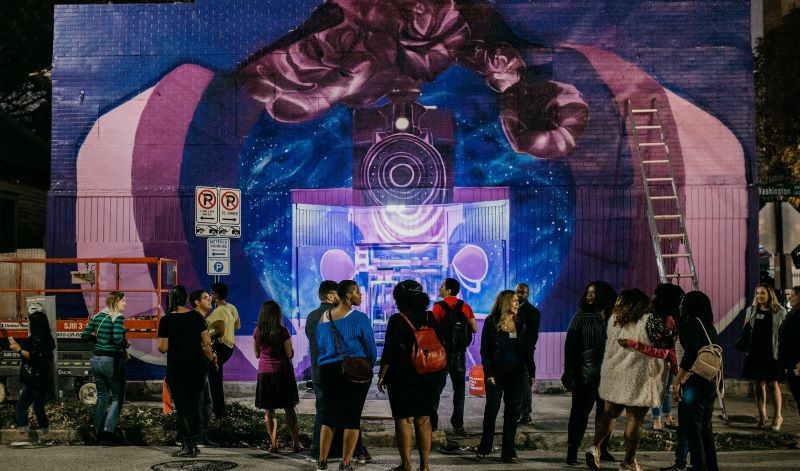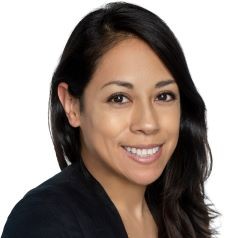Equally importantly, how does a non-profit whose mission is to support the efforts of all those and other artists, persuade these often solitary creators that community may help them out more than they think.
"During the pandemic, Fresh Arts, we really leaned into having more artists' conversations. It forced us to look at virtual programing, doing Facebook Live and live streaming which we had never done before. And we moved away from the workshop, topic-based programming and really focused on 'How are our artists getting through this time,'" says Angela Carranza who has just been named the new executive director.
Carranza, who has been a part of Fresh Arts for going on 11 years, has been named to the organization's top position at a challenging time. She is charged with not only continuing the work it has done but finding new ways for it to be relevant today among members whose own lives have changed significantly.
"I'm moving to a place where I can be out of the weeds and focus on where we can push Fresh Arts forward," she says. Right now she is busy transferring her knowledge just as the non-profit is walking into its 20th anniversary.
This fall Fresh Arts completed an artist's survey and found an overwhelming demand for housing, she says. "Our artists lost spaces to perform, opportunities to work. We did see that artists have been moving out of the concentrated area of inner city Houston and moving more to the suburbs. So that is still a prevalent issue that's happening right now."
"I know plenty of artists who moved their studio practice inside their own home without realizing 'Oh, I don't have as much space as I thought I do.'"
In many cases, artists had to put artistic endeavors to the side, but in others, people embraced their artist side deciding that was really what they wanted to do with their lives, Carranza says.
"There were many artists who had to stop what they were doing creatively and focus on 'How do I keep food on the table; how do I continue paying my rent' and then you had plenty of artists who maybe had those moments of darkness and art got them through it. Artists who switched careers. Artists who hadn't realized their fulltime job was not meaningful."
The survey showed that health care also weighed heavily on many local artists' minds.
"A lot of our programs have not historically addressed healthcare," Carranza says. "What we learned was that a lot of artists, especially during the pandemic, took on other jobs that gave them access to healthcare that they normally wouldn't have if they were just independent artists and just running their own business. So healthcare still remains an issue.
"One of the things we will be looking at this year is how can we find solutions for artists, what opportunities exist looking at other cities with models that provide healthcare access for artists to see there are any alignments that Fresh Arts can help or start conversations in that direction to provide that for artists."
They also found from their survey that the idea of success has changed since the pandemic, she says. "Particularly during the pandemic because businesses were shuttered and artists were losing income, the definition of success wasn't the amount of money you brought in from your creative practice, it was the heart behind what you’re doing; the ability to express yourself and do the work that you want to do creatively."
Which in turn, sparked a change in perspective for Fresh Arts, she says.
"We're really thinking less about how artists can continue their business practices and really thinking about how can artists thrive, not just survive. Looking at the artists holistically." The programming they do acknowledges the struggles in any artist's life and provides some solutions and strategies, she says. "And also holding space to highlight the successes, which are so easy to overlook when you're in hustle mode."
A visit to the Fresh Arts website shows an artist resource library that includes information on health resources, marketing and branding, fundraising and grants and finances and budgeting. Opportunities for work are listed as are upcoming events.
The 501(c)(3) began as a merger of Spacetaker and Fresh Arts Coalition. Carranza started on the Spacetaker side as an intern. Spacetaker was primarily looking at individual artists needing space to showcase themselves online at a time in the early 2000s when websites were expensive, she says.Fresh Arts Coalition was focused on small arts organizations, how they marketed themselves. How could they join forces to showcase what everyone was doing.
Since the merger the biggest change in the past couple of years has been the increase in a virtual presence so that Fresh Art's resources are evergreen and accessible, she says.
"Prior to the pandemic we really didn't record any of our workshops. If you couldn't attend a workshop, you just missed it," she says.
"So now we're looking at how can we move toward a hybrid model of still having those in-person workshops which will begin again this year because artists still want those in-person events, but also realizing that not everyone is comfortable with that and also realizing that some people don't live inside the loop and it may not be easy for them to come to our programming; how can we meet their needs.""Prior to the pandemic we really didn't record any of our workshops. If you couldn't attend a workshop, you just missed it."
tweet this
Asked what her vision is, she laughs and says she's heard that question a lot since she assumed her new position.
"My vision something that’s been bubbling up. It's something that's not singular. It's very much a shared vision. It includes our team members and our board; it's been communicated to us by the artists we serve. My vision is for a deeper connection with the artist community."
Years ago, she says, when she first found Fresh Arts she "wasn’t really aware that any organization really cared about artists" and at the time she was feeling a lot of negativity from well-meaning friends and relatives asking "What are you going to do with an art degree?" She readily acknowledges that while she's happy with how her career path has turned out, things might have gone differently if as a young artist she had more initial support.
"Creating art in any form there’s a level of vulnerability that you're allowing yourself to live in and then when you share your work to the world with others for feedback for critiques for wanting them to enjoy it as much as you do, that’s one part of it . The other part is again you are sometimes working in silos, you're working in isolation and not knowing how to connect with others. It’s a definite problem in the community and it's one we acknowledge in wanting people to feel like you’re not alone."
"You can call us. You can email us. We may not always have a solution but we can point you in the right direction so that you feel like you're not alone."



